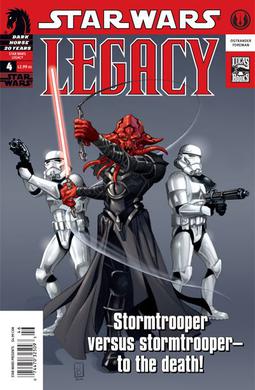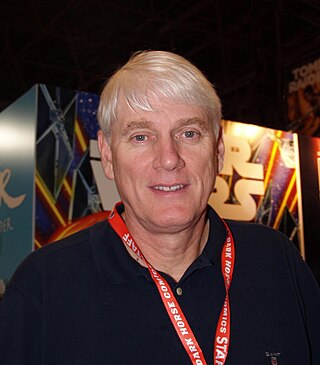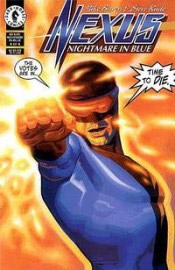
Little Lulu is a comic strip created in 1935 by American author Marjorie Henderson Buell. The character, Lulu Moppet, debuted in The Saturday Evening Post on February 23, 1935, in a single panel, appearing as a flower girl at a wedding and mischievously strewing the aisle with banana peels. Little Lulu replaced Carl Anderson's Henry, which had been picked up for distribution by King Features Syndicate. The Little Lulu panel continued to run weekly in The Saturday Evening Post until December 30, 1944.

Turok is a fictional character who first appeared in American comic books published by Western Publishing through licensee Dell Comics. He first appeared in Four Color Comics #596. After a second Four Color appearance, the character graduated to his own title – Turok, Son of Stone – published by both Dell and then Gold Key Comics from 1956 to 1982. Subsequently, he appeared in titles published by Valiant Comics, Dark Horse Comics and Dynamite Comics.
Guy Davis is an American creature designer, concept artist, illustrator and storyboard artist who has worked on film, television, comic book and video game projects. He is known for his collaborations with filmmaker Guillermo del Toro, including the television series The Strain (2014–17) and the films Pacific Rim (2013), Crimson Peak (2015) and The Shape of Water (2017). Beforehand, Davis was the regular artist for the Hellboy spinoff comic B.P.R.D. (2003–2010), as well as the artist behind his own creator-owned comic The Marquis (2009).

Aliens vs. Predator is a comic book series published by Dark Horse Comics between 1989 and 2020 on an intermittent basis, written and drawn by various artists. Dark Horse also publishes the Aliens and Predator lines of comics.

Ghost is the fictional superhero of an eponymous comic book published by American company Dark Horse Comics. The character appeared in specials and monthly titles detailing the afterlife of Elisa Cameron and her search for the truth surrounding her (apparent) death.

Alien Legion is an American science fiction comic-book series, with several associated titles, created by Carl Potts, Alan Zelenetz, and Frank Cirocco for Marvel Comics's Epic Comics imprint in 1983. It features a military unit, Force Nomad, similar to the French Foreign Legion.

Steve Rude is an American comics artist. He is best known as the co-creator of Nexus.
Ian Edginton is a British comic book writer, known for his work on such titles as X-Force, Scarlet Traces, H. G. Wells' The War of the Worlds and Leviathan.
Andrew Watson is a British cartoonist and illustrator best known for the graphic novels Breakfast After Noon, Slow News Day and his series Skeleton Key and Love Fights, published by Oni Press and Slave Labor Graphics.

Aliens is a line of several comic books set in the fictional universe of the Alien films published by Dark Horse Comics from 1988 forward. The stories often feature the company Weyland-Yutani and the United States Colonial Marines. Originally intended as a sequel to James Cameron's 1986 film Aliens, the first mini-series features the characters of Rebecca "Newt" Jorden and Corporal Dwayne Hicks. Later series also included the further adventures of Ellen Ripley, with other stories being unique to the Alien universe and are often used to explore other aspects of the species, such as their sociology and biology, and also tying into Dark Horse Comics' Predator and Aliens vs. Predator lines. The novels by Titan Books also crossed over with the comics leading to some shared continuity.

Star Wars: Legacy is an American comic book series set in the Star Wars universe. The series, published by Dark Horse Comics, is written by John Ostrander and Jan Duursema, and illustrated by Duursema and others, with inks by Dan Parsons and color by Brad Anderson. Issue #0, which cost 25¢ and introduced the setting and major characters, was released on June 7, 2006.

John Carter, Warlord of Mars is a comics series published from 1977 by American company Marvel Comics. Created by Marv Wolfman (writer) and Gil Kane (penciller), it was based on the Barsoom series of Edgar Rice Burroughs and featured the eponymous character.

Eric Powell is an American comic book writer/artist, best known as the creator of The Goon.

The Indiana Jones franchise has appeared in many comic books. Marvel Comics initially held the comic book licensing rights before they were acquired by Dark Horse Comics in 1990. Marvel published adaptations of the films Raiders of the Lost Ark, Indiana Jones and the Temple of Doom, and Indiana Jones and the Last Crusade, while Dark Horse adapted the Indiana Jones and the Fate of Atlantis video game, The Young Indiana Jones Chronicles television series, and Indiana Jones and the Kingdom of the Crystal Skull.

Tarzan, a fictional character created by Edgar Rice Burroughs, first appeared in the 1912 novel Tarzan of the Apes, and then in 23 sequels. The character proved immensely popular and quickly made the jump to other media, including comics.

Mike Richardson is an American publisher, writer, and producer. In 1986, he founded Dark Horse Comics, an international publishing house located in Milwaukie, Oregon. Richardson is also the founder and President of the Things From Another World retail chain and president of Dark Horse Entertainment, which has developed and produced numerous projects for film and television based on Dark Horse properties or licensed properties.
Arvid Nelson is an American comic book writer, best known for Rex Mundi.
The Fillbach Brothers are comic book artists, known for penciling the Dark Horse Comics Star Wars: Clone Wars Adventures series.













